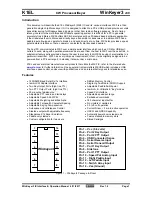
ROC800-Series Instruction Manual
1-16
General Information
Revised July-2017
is recorded along with a date and time stamp. The Alarm Log records
the last 450 configured occurrences of alarms (set and clear). You can
view the logs, save them to a disk file, or print them using ROCLINK
800 software.
ROC800L
To accommodate NIST Handbook 44 (HB 44) requirements, the
firmware in the ROC800L tracks up to 1000 weights and measures
(W&M) events.
1.5.2 Meter Runs and Stations
You can group similarly configured meter runs into stations, which
provide great benefits during configuration and reporting. You can also
configure each meter run, which eliminates redundant meter run data
within a station and enables faster data processing.
You can group meter runs among the maximum of twelve stations in
any combination. Meter runs belong in the same station when they have
the same gas composition data and calculation methods. Stations allow
you to:
▪
Set contract hours differently for each station.
▪
Designate several individual meter runs as part of a station.
▪
Configure one to twelve meter runs for each station.
Note
:
For the ROC800L, you configure runs and stations using the
individual user programs.
1.5.3 ROC800 Flow Calculations
For the ROC800, gas and liquid calculation methods include:
▪
AGA and API Chapter 21 compliant for AGA linear and differential
meter types.
▪
AGA 3 – Orifice Plates for gas.
▪
AGA 7 – Turbine Meters (ISO 9951) for gas.
▪
AGA 8 – Compressibility for Detailed (ISO 12213-2), Gross I (ISO
12213-3), and Gross II for gas.
▪
ISO 5167 – Orifice Plates for liquid.
▪
API 12 – Turbine Meters for liquid.
ROC800 firmware completes full calculations every second on all
configured runs (up to 12) for AGA 3, AGA 7, AGA 8, ISO 5167, and
ISO 9951.
AGA 3 calculations conform to the methods described in American Gas
Association Report No. 3, Orifice Metering of Natural Gas and Other
Related Hydrocarbon Fluids. Based on the second and third editions, the
calculation method is 1992 AGA 3.
















































